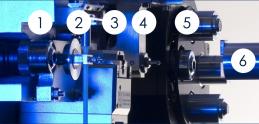Imaging & Positioning
2D and 3D Imaging

In order to target/avoid specific structures or features on samples, all NanoTest systems are equipped with multiple-objective optical microscope. The optical microscope is also useful for reviewing residual damage post-experiment.
In addition to the multiple-objective microscope, a side-view optics microscope is supplied with the system to provide the convenience of a close-up view of the indenter and sample.
The NanoTest systems can also be configured with additional imaging capabilities including high temperature optics, an in-situ 3D nanopositioning stage, and an AFM.
How it works
The sample stage features five measurement positions as shown below. All of these capabilities are optional, as the NanoTest systems can be configured to meet the requirements of the customer.
- 1: High temperature optics

- 2: Low Load Head
- 3: AFM
- 4: High Load Head
- 5: Multiple Objective Microscope
The sample (6) automatically moves between the loading heads and the imaging devices via software control. The high accuracy stages used by the NanoTest systems provides a resolution of 20 nm and a re-positioning accuracy of < 400 nm.
Standard Optics on the NanoTest Vantage
The NanoTest is supplied with a multiple-objective microscope, and side-view optics as standard. The multiple objective microscope has two lenses mounted in a precision shuttle mechanism for accurate re-positioning. Lenses are selected using software control. The two lenses, as well as 2x digital zoom allows wide and precise positioning on samples, and the ‘point-and-click’ functionality ensures quick and easily movement.








